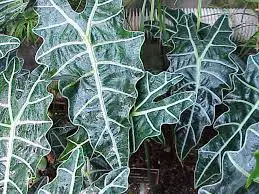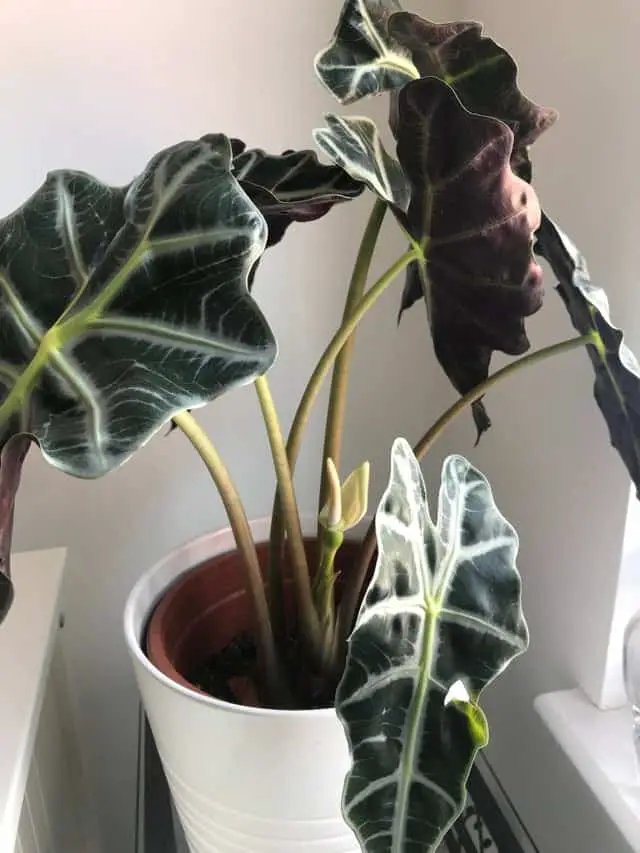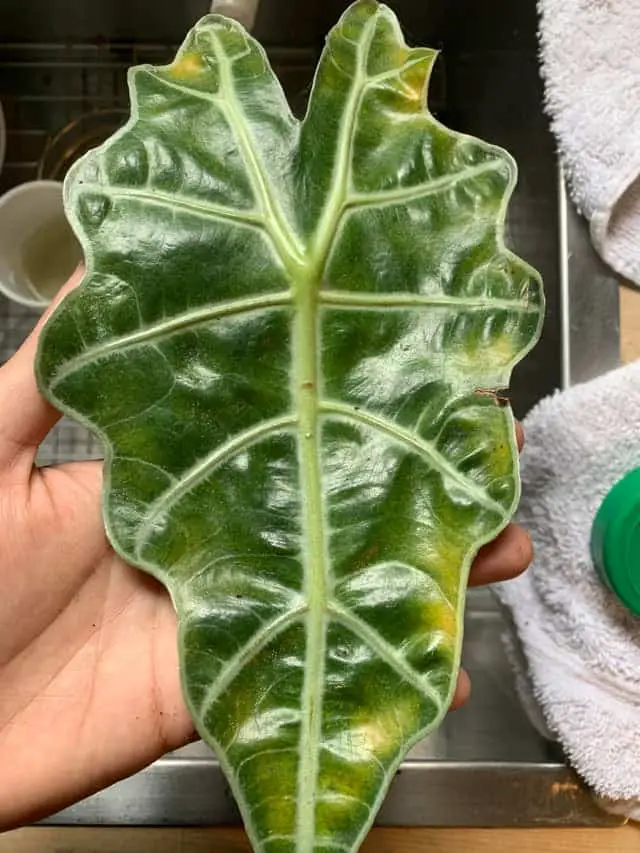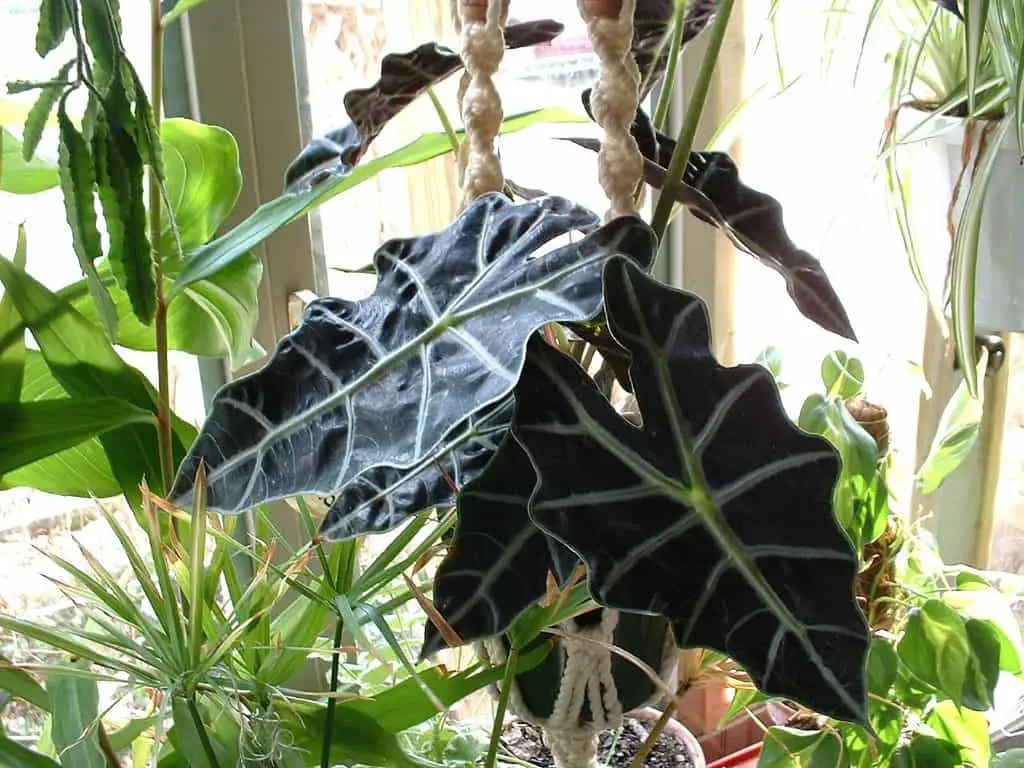Alocasia x amazonica, which is commonly known as Kris Plant, African Mask Plant, or Elephant’s Ear, is a houseplant that is known for its striking leaves. The leaves have a triangular shape and contain light-colored veins. Interestingly, the leaves also have a waxy cuticle which gives the leaves a shiny appearance. I have been wanting one of these plants for a little over a year now, and I finally found one the other day at Sherman Library & Gardens in Corona Del Mar, California. After thoroughly researching the best ways to care for these plants, I found that the African Mask Plant has a reputation for being a little fussy.
To properly care for African Mask Plant, it is important to make sure the plant is grown in well-draining soil and is placed in a spot that is exposed to plenty of bright, indirect light. In addition, it is important to keep the soil moist (not soggy) at all times. Do not let this plant completely dry out between watering sessions. Finally, it is important to frequently check the underside of your plant’s leaves for spider mites.
The rest of this blog post will provide some interesting facts about the African Mask Plant as well as a detailed description of how to care for this beautiful plant.
About African Mask Plant
Alocasia x amazonica is actually a cross between other Alocasias rather than a naturally occurring species. According to Bill Rotolante, who is the President of Silver Chrome Gardens, Inc. in Homestead, Florida, Alocasia amazonica is either a hybrid of Alocasia longiloba and Alocasia sanderiana or a cross between Alocasia longiloba and Alocasia nobilis.
The Alocasia genus is comprised of about 80 broad-leaved rhizomatous or tuberous perennial flowering plants. These plants are native to the tropical and sub-tropical regions of Asia and Eastern Australia. Several plants belonging to this genus are grown as ornamental houseplants, and there are many hybrids grown in cultivation. Some of these plants can be rather expensive and difficult to find.
Alocasia amazonica is often confused for Alocasia sanderiana which is not a hybrid. Alocasia sanderiana is endemic to the Philippines and tends to have larger leaf lobes than Alocasia Amazonica.

Alocasia amazonica 
Alocasia sanderiana
African Mask Plant Blooms
Although these plants are typically grown for their attractive foliage rather than the flowers, African Mask Plant does produce blooms that look similar to flowers found on other plants belonging to the Araceae family. These plants produce a white to yellow or light green spathe surrounding the spadix. A spathe is a leaf-like structure while a spadix is a spike comprised of small, closely arranged flowers. Unfortunately, blooming is fairly rare, especially for plants grown indoors.
Some aroids have unisexual flowers located within the spadix while other species have bisexual flowers. Alocasias have bisexual flowers. The female flowers (pistillate) are located in the floral chamber, and the male flowers (stamen) are located in the upper part of the spadix. The pistillate and stamen are not ready for pollination at the same time. For this reason, cross-pollination, or pollination with another plant, is necessary for these plants to reproduce.

Source: Reddit User modernrenaissance_
Some gardeners recommend removing Alocasia blooms because they require so much of the plant’s energy. This energy is taken away from the foliage and can cause the leaves to become brown or yellow. Others believe that flowering is a natural process that should not be disturbed.
Growing African Mask Plant Outdoors
Although this plant is typically grown as a houseplant, it can be grown outdoors in certain conditions. They grow best in United States Department of Agriculture (USDA) Hardiness Zones 10 and 11.
In most places, they will do outside during the summertime and can be brought indoors during the wintertime. When putting your plant outdoors during the summer, make sure you put it in a location with some shade. Like most plants, African Mask Plant needs to adapt to more intense lighting conditions.
History Of African Mask Plant Cultivation
The term Alocasia x amazonica first appeared in a Florida State Horticultural Society publication in 1953. This hybrid was developed by Salvadore Mauro, who owned Amazon Nursery in Miami, Florida, in the 1950s.
Although some sources have indicated that Alocasia x amazonica was first described in a scientific paper written by botanist Éduard François André (1840-1911), the United States Department of Agriculture (USDA) has formally acknowledged that Alocasia amazonica is a horticultural name rather than a scientific name.
Some sources also indicate that Alocasia x amazonica is the same plant as Alocasia Polly. However, they are actually different plants. Alocasia Polly is a hybrid plant that tends to be smaller than Alocasia x amazonica.
Watering African Mask Plant
African Mask Plant should be grown in soil that is kept constantly moist (but not soaking wet). As a general rule, you should allow the soil to dry about 50% before watering again. This means the soil surface should dry out between watering sessions but not the entire soil profile. One way to determine whether you should water, use the “finger test.” This involves sticking your finger in the soil profile and watering if the top couple of inches are pretty dry.
It is best to use water that has a low chlorine content to water these plants. Alocasias can be sensitive to the chlorine in tap water. Try using filtered water or leave water out in a bowl for a few hours (to allow the chlorine to evaporate) before adding it to your plant’s container.
African Mask Plant tends to go dormant during the late fall and winter (when temperatures dip below 60°F). During this time, you should reduce (but not eliminate) the amount of watering.
Yellowing leaves are typically a sign of overwatering or underwatering. If you see the leaves of your plant starting to yellow, back off on the watering unless you are fairly certain that you have not been watering very frequently.
Lighting Requirements For African Mask Plant
Like most tropical plants, Alocasias need to be exposed to plenty of bright, indirect light. However, they should not be placed in a location that gets harsh, direct light as the leaves can burn. This means that you should avoid direct southern exposure. When picking a spot for your African Mask Plant, try to mimic their natural habitat. In the wild, these plants grow on the forest floor – below a canopy of trees.
Cleaning The Leaves Of African Mask Plant
It is important to clean the leaves of your African Mask Plant. Not only does cleaning the leaves improve the aesthetics, but removing dust from the leaves also ensures that the plant is able to absorb light and photosynthesize properly. As you may have noticed, a layer of dust tends to accumulate on plant leaves over time. This layer of dust blocks sunlight and reduces the plant’s ability to photosynthesize.
The easiest way to clean the leaves of your plant is to spray the leaves with plain water. After cleaning the leaves, rinse off the leaves in the sink or with a hose. If possible, I recommend avoiding the use of soapy water on your African Mask Plant. This is because soap can damage the waxy cuticle of the leaves.
Another way to clean your plants is to gently wipe off the leaves with a damp cloth. Personally, I find this method to be therapeutic. It is also a good opportunity to closely inspect your plant and identify any possible pest or disease issues.
I recommend cleaning the leaves of your plants on a monthly basis. If you live in a dusty area or near a construction site, consider cleaning the leaves of your African Mask Plant more frequently.
Best Soil For African Mask Plant
Like other aroids, African Mask Plant should be grown in well-draining soil to prevent overwatering. The best potting mix for African Mask Plant consists of one part potting soil, one part perlite, and one part peat. Adding some pine bark and compost to that soil mix will promote healthy plant growth.
If you do not like to mix your own soil, purchase a potting soil that works well for tropical plants or bromeliads. If you tend to overwater your plant, I strongly recommend adding some perlite to improve drainage. Adding perlite allows water to move through the soil profile more quickly so that the roots do not get “wet feet.”
Best Humidity Levels For African Mask Plant
Like other plants belonging to the Araceae (aroids) family, African Mask Plant should be grown in a humid environment. If this plant is exposed to dry conditions, the tips of the leaves will turn brown. Ideally, this plant should be in an environment with a relative humidity of around 60%. However, the relative humidity in an average home ranges from 40% to 50%.
You can do a few things to make sure your plant is exposed to enough humidity. The first way to increase relative humidity is to run a plant humidifier in the vicinity of the plants. Ideally, you should purchase an evaporative or ultrasonic cool mist unit. Other types of humidifiers can release a significant amount of heat which can adversely impact plant health.
Alternatively, you can also run an essential oil diffuser as a humidifier. Simply run the essential oil diffuser with water rather than essential oils. It is important to note that an essential oil diffuser will not run as long or with as much water as a humidifier.
Fertilizing African Mask Plant
To fertilize these plants, apply a houseplant fertilizer every month or two. These plants grow rather quickly, so they will definitely benefit from some fertilization. If you begin to see spotting on your plant’s leaves, stop fertilizing for a while and flush the soil profile. Alocasias can be sensitive to excessive salts and minerals, which cause spotting on the leaves.
If your plant is growing in a soil mix that contains slow-release fertilizer (the soil will have little balls in it), you do not need to apply any additional fertilizer for six months.
Repotting African Mask Plant
Repot African Mask Plant every 3-4 years depending on how quickly the plant grows. It is best to repot African Mask Plant during the spring or summer. Like many other types of plants, it is best to repot the African Mask Plant into a container that is only one to two inches larger.
African Mask Plant prefers to grow in smaller containers, which is why you only need to repot this plant every couple of years depending on how quickly your plant grows. Growing plants in a tighter pot minimize overwatering because the plant’s roots are able to take up the water from surrounding soil more quickly in a smaller pot.
Potential Pest Problems Encountered By African Mask Plant Owners
Like other Alocasias, African Mask Plant is prone to spider mites. To avoid a big infestation of spider mites, check the underside of the leaves frequently for any webbing or signs of spider mites. Yellowing leaves can also be a sign of spider mite issues. If you see any webbing, isolate the plant and gently wipe down the leaves. More serious infestations may require the use of neem oil or insecticidal oil.

Source: Reddit User gotmyplantsontop
Is African Mask Plant Toxic?
According to the American Society for the Prevention of Cruelty to Animals (ASPCA), African Mask Plant is toxic to cats and dogs. Chewing or consuming this plant can cause vomiting, pain and swelling in the lips or mouth, and excessive drooling. In rare cases, swelling may occur in the upper respiratory tract which makes it difficult for the animal to breathe. If you believe that your pet has ingested part of your African Mask Plant (or any other plant), call your veterinarian or local pet clinic immediately.
You may be wondering how a plant can cause such pain. Like many houseplants, the African Mask Plant contains insoluble calcium oxalates which are salts with a crystalline structure. These salts are often responsible for causing kidney stones in humans. When animals chew on plant leaves that contain calcium oxalates, the plant releases these crystals. At this point, there are many small, needlelike crystals stabbing the mouth. This is what causes the pain and swelling.

Although consuming African Mask Plant rarely kills pets, it is best to put your plant in a location that is not accessible to your animals.
Related Questions
Why are my African Mask Plant’s leaves drooping?
Droopy leaves are typically a sign of underwatering or insufficient light.

